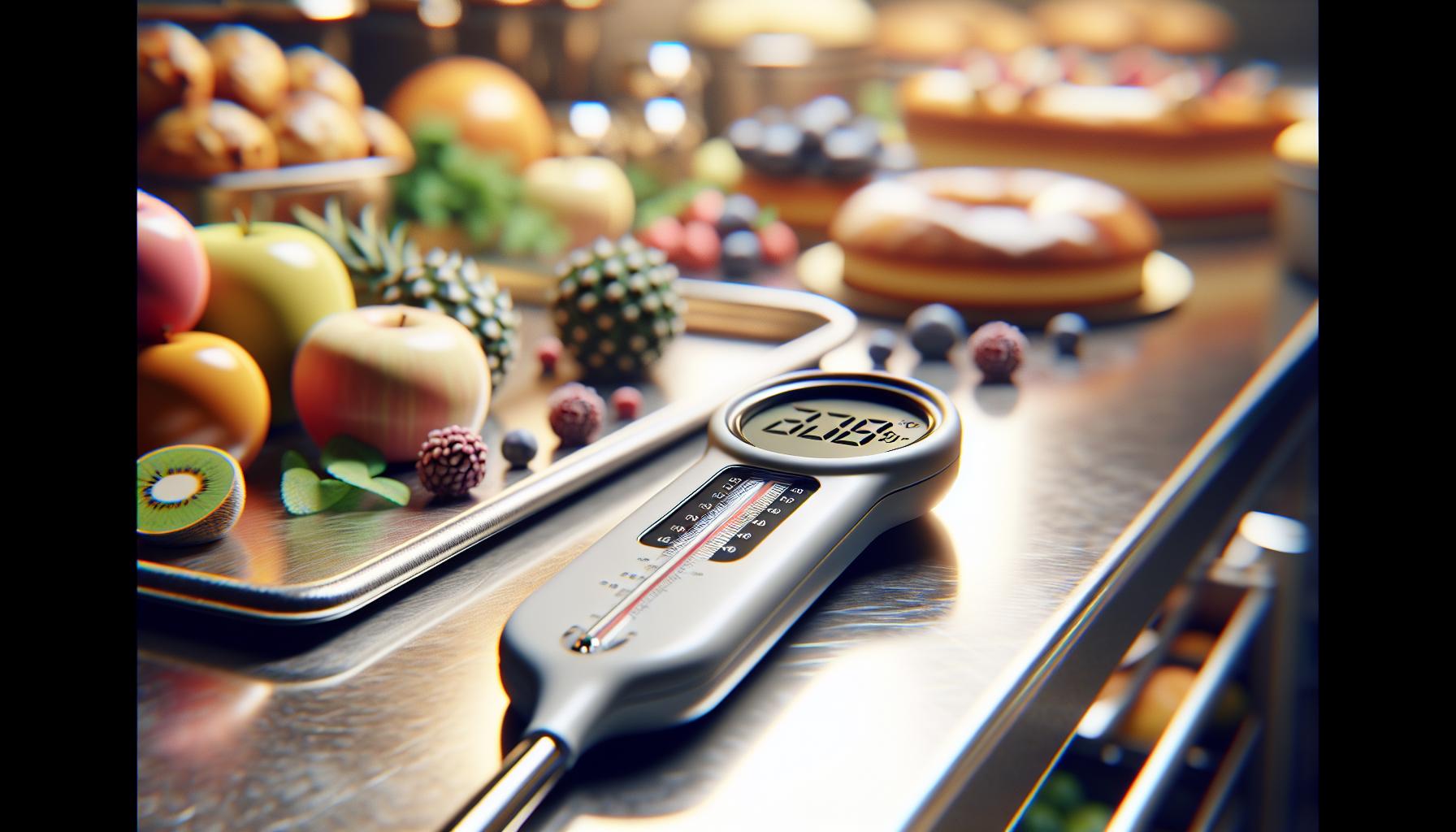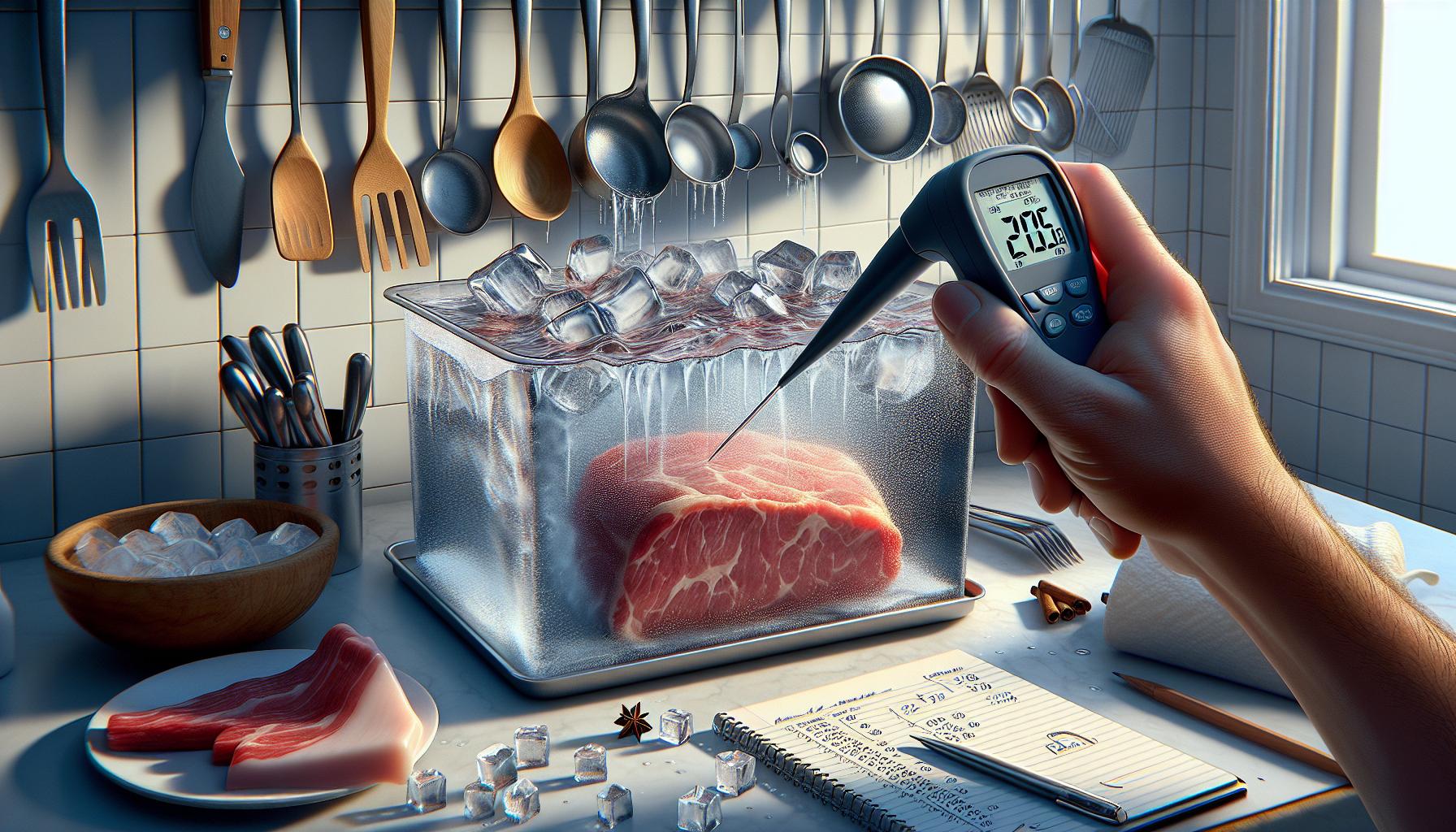
Nobody wants their dinner to become a science experiment in foodborne illness. Properly thawing Temperature Control for Safety (TCS) foods isn’t just about getting that chicken breast ready for cooking – it’s about keeping harmful bacteria from turning your kitchen into a microbial party zone.
From restaurants to home kitchens, knowing the correct thawing methods for TCS foods can mean the difference between a delicious meal and an unwanted trip to the emergency room. The FDA has established specific guidelines to ensure food stays safe during the thawing process while maintaining its quality and nutritional value. Let’s explore the proper techniques that’ll keep your food safe and your dining guests happy – without any uninvited bacterial guests.
What Is A Correct Way To Thaw Temperature Control For Safety Food (TCS)?
Temperature Control for Safety (TCS) foods require specific temperature monitoring to prevent bacterial growth. These foods contain moisture content protein that supports rapid multiplication of microorganisms.
Common Examples of TCS Foods
TCS foods include:
- Raw animal proteins: beef poultry fish eggs
- Dairy products: milk cheese yogurt butter
- Cooked vegetables rice beans pasta
- Cut melons tomatoes leafy greens
- Garlic or herbs in oil mixtures
- Sprouts bean alfalfa
- Tofu other soy proteins
- Shell eggs untreated garlic-oil mixtures
| Food Category | Safe Cold Storage Temperature |
|---|---|
| Raw Meat | 41°F (5°C) or below |
| Dairy Products | 41°F (5°C) or below |
| Cut Produce | 41°F (5°C) or below |
| Cooked Foods | 41°F (5°C) or below |
Why Proper Thawing Matters for Food Safety
Proper thawing prevents dangerous temperature zones where bacteria multiply rapidly. Food particles remain in the danger zone (41°F-135°F/5°C-57°C) when thawed incorrectly. Bacterial growth accelerates at these temperatures creating toxins that cause foodborne illness. Temperature abuse during thawing compromises food quality texture flavor. Safe thawing maintains consistent temperatures throughout the food item. Proper methods protect both product integrity consumer health. The FDA reports improper thawing contributes to 48% of foodborne illness outbreaks in food service operations.
| Temperature Zone | Bacterial Growth Rate |
|---|---|
| 41°F-135°F | Rapid multiplication |
| Below 41°F | Significantly slowed |
| Above 135°F | Most bacteria die |
Four Safe Methods for Thawing TCS Foods

Food service establishments use four FDA-approved methods to safely thaw Temperature Control for Safety (TCS) foods. Each method maintains proper temperature control throughout the thawing process to prevent bacterial growth.
Refrigeration Method
The refrigeration method keeps TCS foods at 41°F (5°C) while thawing. Place frozen food items in sealed containers on the bottom shelf of the refrigerator to prevent cross-contamination from drips. Large items like turkeys require 24 hours of thawing time for every 5 pounds of weight. Store thawing foods away from ready-to-eat items to maintain food safety standards. This method takes longer than other approaches but provides the most consistent temperature control.
Running Cold Water Method
Cold water thawing accelerates the process while maintaining safe temperatures. Submerge sealed food packages in cold running water at 70°F (21°C) or below. The water flow breaks up the cold air barrier around the food, speeding up thawing. Small portions thaw within 2 hours using this method. Check water temperature every 30 minutes to ensure it stays cold. Change the water every 30 minutes if using standing water instead of running water.
Microwave Thawing
Microwave thawing requires immediate cooking after completion. Remove all packaging materials before placing food in microwave-safe containers. Use the defrost setting or 30% power level to ensure even thawing. Rotate food items every 2-3 minutes for uniform temperature distribution. Monitor internal temperatures throughout the process. This method works best for smaller portions under 1 pound.
| Food Type | Minimum Internal Temperature |
|---|---|
| Poultry | 165°F (74°C) |
| Ground Meat | 155°F (68°C) |
| Seafood | 145°F (63°C) |
| Vegetables | 135°F (57°C) |
Critical Temperature Zones During Thawing

Temperature monitoring during the thawing process prevents bacterial growth in TCS foods. Understanding these critical zones ensures food safety throughout the thawing process.
Danger Zone Temperatures
The temperature danger zone spans from 41°F to 135°F (5°C to 57°C), where bacteria multiply most rapidly. Food items in this range experience bacterial cell counts doubling every 20 minutes. TCS foods left at room temperature (70°F/21°C) enter the peak danger zone, creating optimal conditions for pathogenic growth. The most hazardous range occurs between 70°F and 125°F (21°C to 52°C), where common foodborne pathogens like E. coli thrive.
- Recording start times for thawing
- Measuring surface temperatures every 2 hours
- Documenting ambient temperature conditions
- Tracking total time in the danger zone
- Verifying final internal temperatures
Best Practices for Monitoring the Thawing Process

Effective monitoring of TCS food thawing requires precise temperature measurement and detailed documentation. These practices ensure food safety compliance and prevent bacterial growth during the thawing process.
Using Thermometers Correctly
Digital thermometers provide accurate temperature readings for TCS foods during thawing. The probe thermometer insertion point varies by food type:
- Insert into the thickest part of meat cuts avoiding bone contact
- Place between frozen packages for bundled items
- Measure both surface and center temperatures of large portions
- Clean and sanitize the thermometer probe between each measurement
- Calibrate thermometers weekly using ice water (32°F/0°C) or boiling water (212°F/100°C)
- Take multiple readings from different areas for large or irregularly shaped items
- Log start time and initial temperature when beginning the thaw process
- Record ambient temperature of thawing environment
- Document temperature readings every 2 hours during thawing
- Track cumulative time food remains in the danger zone
- Note the thawing method used (refrigeration, cold water, microwave)
- Include employee initials for each temperature check
- Store temperature logs for 90 days for regulatory compliance
- Document corrective actions taken for temperature violations
- Maintain equipment calibration records for thermometers
Common Thawing Mistakes to Avoid
Improper thawing practices create significant food safety risks, leading to bacterial growth and potential foodborne illnesses. Understanding these common mistakes enables food service operators to maintain safer thawing practices.
Unsafe Thawing Methods
Leaving TCS foods on countertops at room temperature creates dangerous bacterial growth conditions. Hot water thawing accelerates bacterial multiplication in outer food layers while centers remain frozen. Defrosting food in plastic bags directly on counters allows temperature fluctuations that compromise safety. Thawing in garage spaces exposes food to uncontrolled temperatures and environmental contaminants. Using fans to speed up thawing introduces airborne bacteria onto food surfaces. Stacking multiple items during thawing prevents even temperature distribution and creates hot spots. Restaurant kitchens often incorrectly thaw foods in sinks without running water, allowing portions to remain in the danger zone for extended periods.
Cross-Contamination Risks
Raw meat juices dripping onto other foods transfer harmful bacteria between items during thawing. Storing thawing meats above ready-to-eat foods in refrigerators allows contaminated liquids to spread pathogens. Using the same containers for raw and cooked foods without proper sanitization spreads bacteria. Inadequate separation between different types of thawing meats enables cross-species contamination. Kitchen tools used for both raw and cooked foods during thawing transfer dangerous microorganisms. Improper handwashing between handling different thawing items spreads contaminants. Storage containers without proper covers expose thawing foods to environmental contamination. Multiple food items thawing in shared containers mix potentially harmful bacteria.
FDA-approved methods
Safe thawing of TCS foods remains a critical component of food safety in both commercial and home kitchens. Following FDA-approved methods – including refrigeration cold running water and microwave thawing – while maintaining proper temperature control significantly reduces the risk of foodborne illnesses.
Accurate temperature monitoring thorough documentation and avoiding common thawing mistakes are essential steps in protecting public health. By implementing these proper thawing techniques food service professionals and home cooks can ensure their TCS foods remain safe and maintain optimal quality from storage to service.
Remember that food safety isn’t just about following rules – it’s about protecting the well-being of everyone who enjoys the prepared meals. Taking the time to thaw TCS foods correctly is worth the effort to prevent foodborne illness outbreaks.


